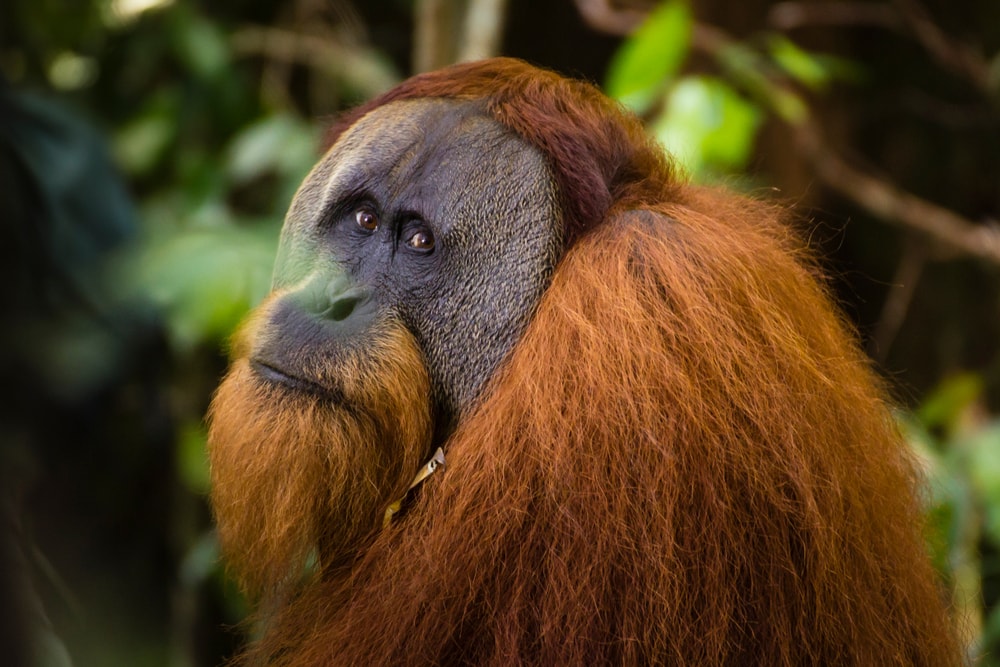Outforia Quicktake: Key Takeaways
- Sumatran orangutans are critically endangered, largely due to habitat loss from deforestation and illegal logging in Sumatra, with an estimated population of 13,846 individuals remaining.
- These apes are highly intelligent, known for their use of tools and ability to communicate through gestures, facial expressions, touch and vocalizations.
- They are native to the island of Sumatra in Indonesia and primarily live in lowland tropical forests, relying on fruits and insects as their main food sources.
- Conservation efforts include rehabilitating and reintroducing captive or displaced individuals, as well as protecting their forest habitats from deforestation.
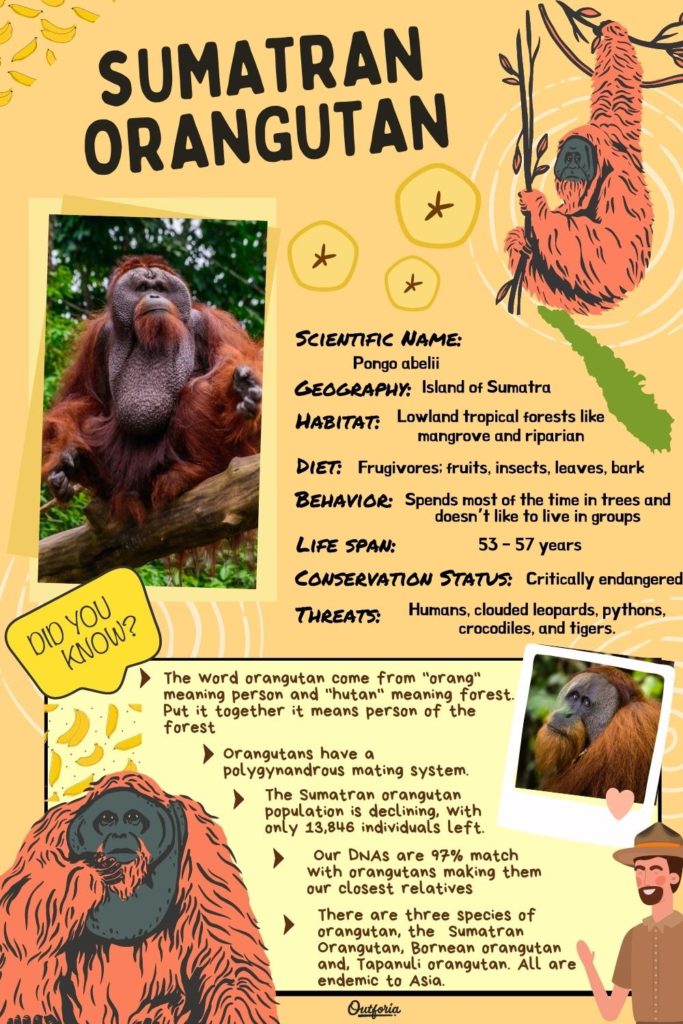
share this image on your site
<a href="https://outforia.com/sumatran-orangutan/"><img style="width:100%;" src="https://outforia.com/wp-content/uploads/2022/09/sumatran-orangutan-infographic-0922-683x1024.jpg"></a><br>Sumatran orangutan<a href="https://outforia.com">Outforia</a>
Sumatran orangutans are one of the most intelligent mammals in the world. Sadly, they are also critically endangered due to habitat loss. These amazing apes know how to use different tools for fruits and insects.
Did you know that they gather tools for their toolbox throughout their life? They have different kinds of sticks for various situations. They also use big leaves as umbrellas. Read on to find out what else orangutans can do.
Classification

The Sumatran orangutan, or by its scientific name, Pongo abelii, belongs to the genus Pongo and Hominidae family, whose members are the great apes. There are a total of three species of orangutans:
- Sumatran Orangutan – native to Sumatra, Indonesia
- Bornean orangutan (Pongo pygmaeus) – native to the island of Borneo
- Tapanuli orangutan (Pongo tapanuliensis) – only in South Tapanuli in Sumatra, Indonesia
All orangutans are endemic to Asia and, unfortunately, endangered. Tapanuli has the largest population, then Sumatra. The Bornean species is the rarest.
Orangutan comes from “orang,” meaning person, and “hutan” from Malay, meaning forest. So, put together, it roughly translates as the ‘person of the forest.
Appearance and Size
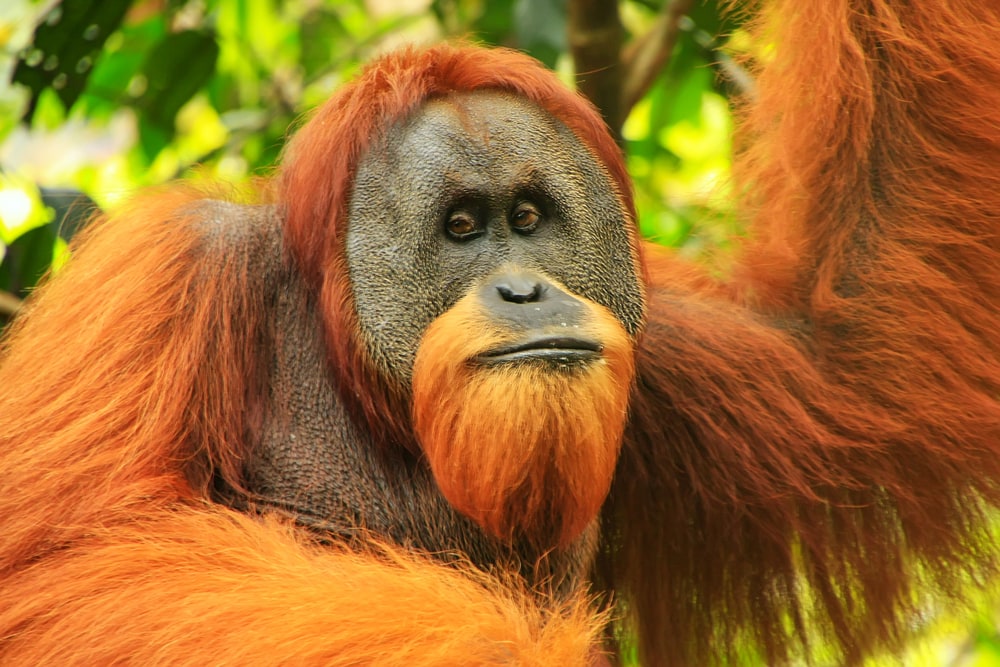
These hairy red apes are the largest arboreal mammals and the only great apes native to Asia. The rest of the great apes, like gorillas, chimpanzees, and bonobos, live in Africa.
Male orangutans grow as tall as 5’6 ft (1.7 cm) and weigh about 200 lb (90 kg). That’s an average size of an adult human male!
Females are a little smaller than their male counterparts, reaching only 3 ft (90 cm) tall and weighing 99 lb (45 kg).
Both males and females have thick bodies, necks, and bowed legs, adapted for tree climbing. Their arms are longer than their feet, and an adult male can reach 7 ft (213cm) arm length.
Also, their arm muscles are mighty. This way, they can support their body weight when swinging from trees. As a result, orangutans are 7 times stronger than humans!
An adult male has cheek pads called flanges, an accumulation of fibrosis tissue. These big cheeks help them communicate louder as if they are using a megaphone. Another exciting adaptation this tree-dweller has is long and curved fingers and toes.
They help them with tree swinging, and they can also grab objects. Besides that, they can use their hands or feet to hold things or eat. They are also highly flexible. For example, they can put their feet in their mouths while hanging upside-down.
Sumatran and Bornean orangutans have different hairs
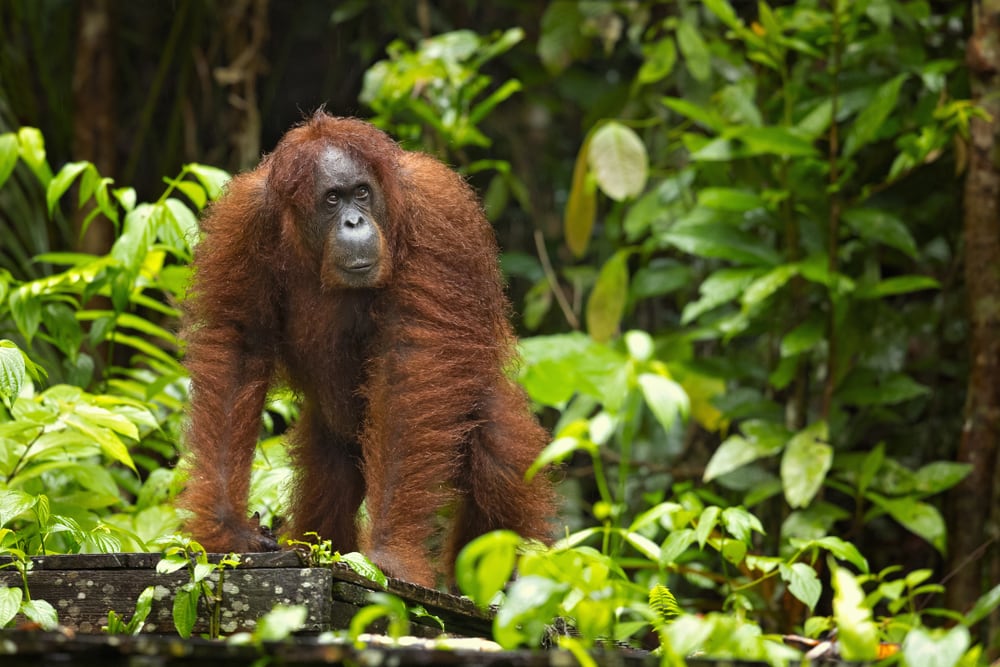
Sumatran orangutans have long, bright orange hairs. The Bornean species has short hairs which are darker in color. Their faces are also different. Sumatran species has a thinner and longer face.
Geography/Distribution/Location
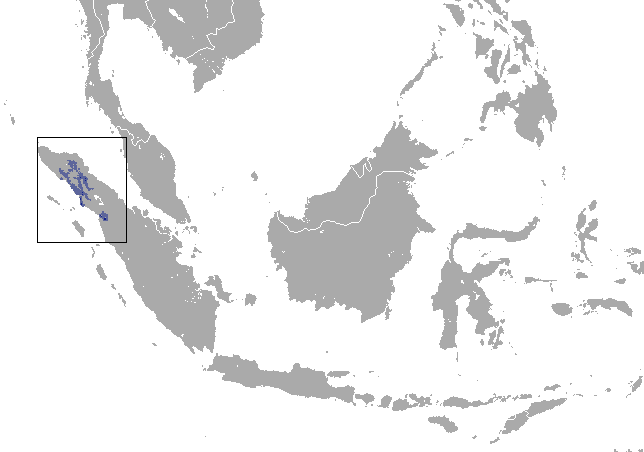
chermundy IUCN Red List of Threatened Species, species assessors and the authors of the spatial data / CC BY-SA 3.0 / Wikimedia commons
Sumatran orangutans only live on the island of Sumatra, the northern part of Indonesia. These orangutans live in low population densities across large home ranges.
Habitat and Climate Zones
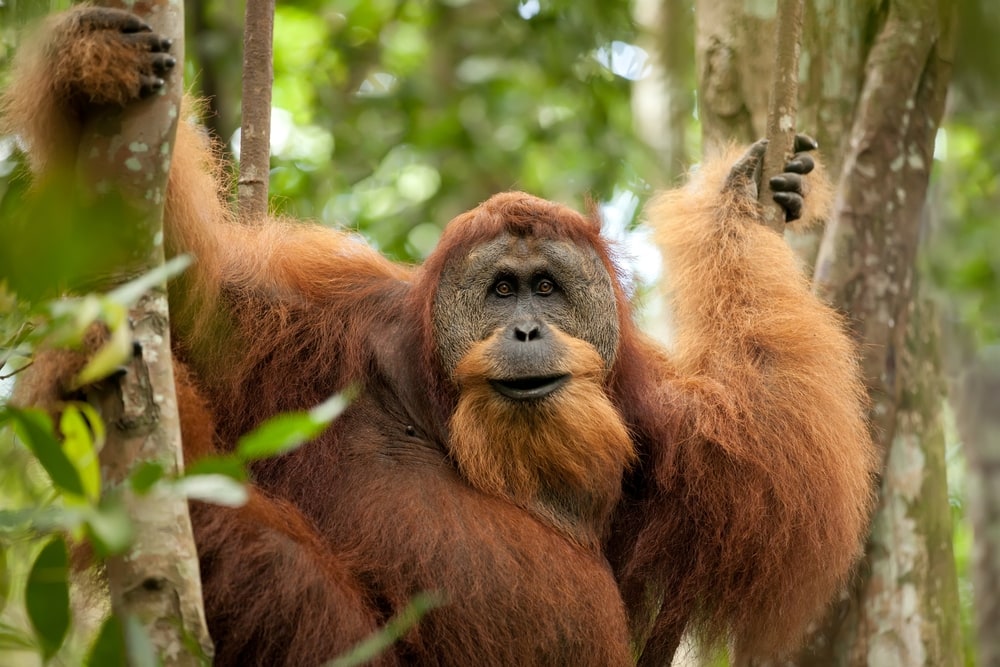
Sumatra has a tropical climate, which is ideal for Sumatran orangutans. Their ideal habitats are lowland tropical forests like mangrove and riparian.
The population density mainly depends on the availability of food. Thus, they usually commute between lowland and highland regions in search of food.
Diet and Food Habits
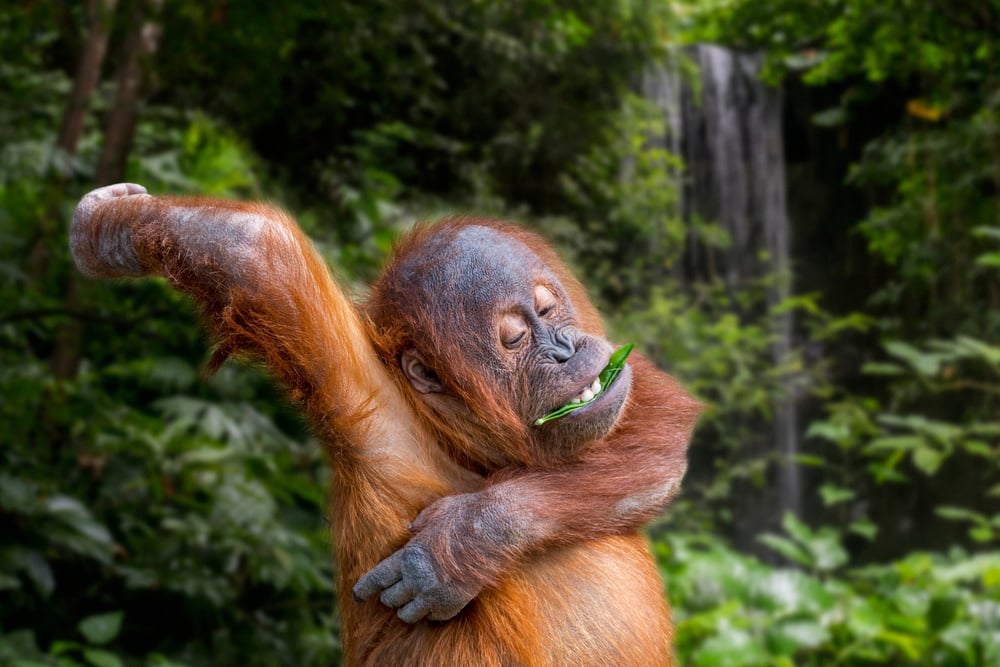
These shaggy apes are mainly frugivores. They like to munch on fruits with big seeds like lychees, jackfruit, and durians. They also eat plenty of insects, ants being their favorites. Their diet includes fruits, insects, leaves, bark, and other items. It all depends on the abundance of food around them.
Mornings and afternoons are for food searching. Middays are for naps when it’s the hottest outside. Mothers and young ones might overlap in their feeding grounds with no problems.
After foraging fruit trees, the young ones play together. The mothers will carefully watch over them. Unlike females, adult males are solitary and prefer to eat alone.
While they get plenty of water from fruits and leaves, they also drink water. Orangutans usually lick tree holes to extract water. They also lick their fur and plant leaves.
Meat-eating Among Sumatran Orangutans
Orangutans don’t usually eat meat. Yet, there is one study conducted in Ketambe that shows different data. People spotted several orangutans eating meat, like slow lorises. Studies show that these mammals resorted to this due to the scarcity of seasonal fruits.
Behavior
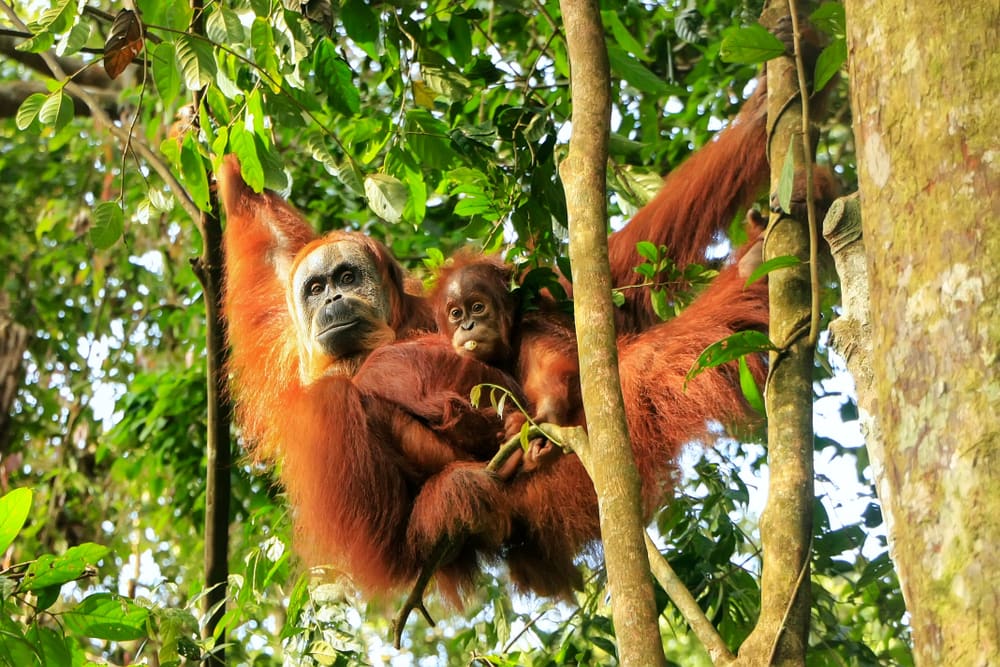
The trees are orangutans’ home, as they spend most of their lives in them. They like to slowly swing from tree to tree to get from one place to another.
However, their arms are so long that they look awkward walking on the ground. So, they usually need to lift their arms; otherwise, they drag them.
These heavy mammals build a nest every night and rarely reuse it. They prefer branches with many leaves to protect themselves from rain or sun. They also cover themselves in leaves!
Sumatran orangutans spend more time in trees than Bornean species. It is because they have to hide from predators like leopards or pythons.
Scientists discover they have up to 64 different gestures. The six most used signs are: play, stop, look at or take an object, share, co-locomote, and move. Their communication relays more on gestures rather than audible communication.
They also communicate through touch, facial expressions, and some vocalizations.
For example, the “kiss-squeak” sound means either fear or excitement. When they make a “grumph” sound, it means annoyance. Finally, mothers make a soft scaping sound to tell their young ones to stay next to them.
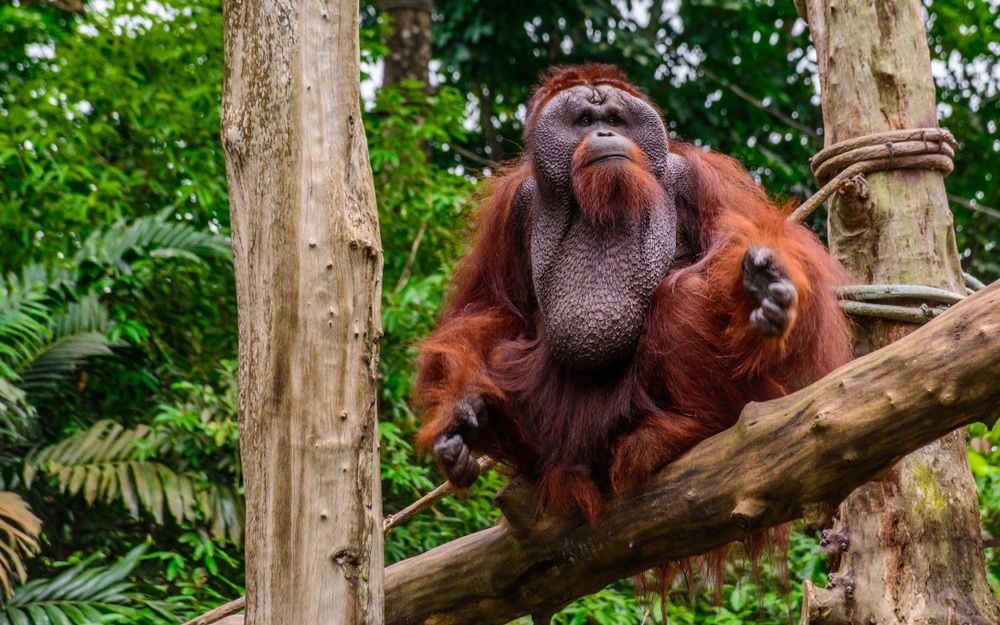
Cheek-padded mates don’t like company and are very territorial. So when males fight, they start breaking branches and charging each other. If none back off, they resort to grabbing and biting each other on the cheek pads or ears until somebody gives in.
Orangutans are intelligent and use tools in their daily lives.
For example, they can break tree branches, take some twigs, and sharpen them with their teeth. Then, they will use those sticks into tree holes in search of termites. Another way orangutans use sticks is by poking a bee’s nest to get to the honey.
They perfect the tools depending on if they need them for fruits of insects. Each situation requires a longer or shorter stick. If a device is good enough, they will keep it for later, gathering entire toolboxes.
You may also like: All The 26 Different Types Of Apes: Pictures, Classification And Chart
Sumatran Orangutan Mating Habits
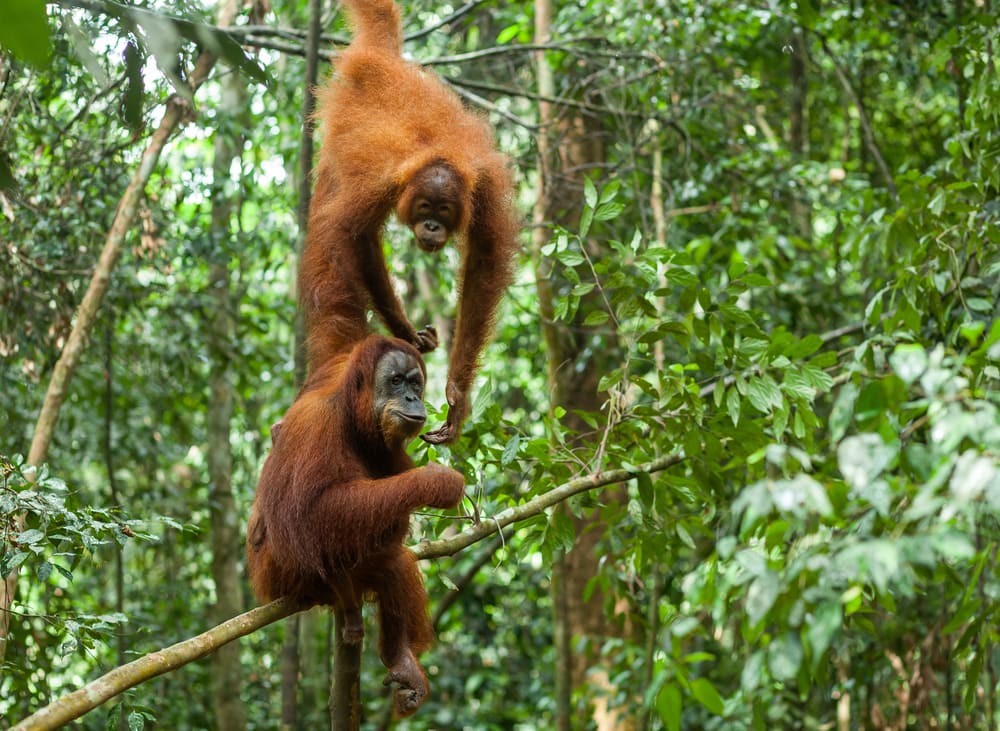
Females have a stable home range of 3.5 square miles (9 km). Males are more nomadic, preferring more extensive home ranges of 15 square miles (39 km). Sometimes these ranges overlap, and males will visit females.
Males will also make a long call, inviting available females in their home range. The size of their cheek pads usually impresses females.
Orangutans have a polygynandrous mating system. Therefore, they have many mating partners during the breeding season.
Mating seasons coincide with the rainy season, from December to May. They reproduce every 7 to 8 years, having the slowest breeding rate of all mammals. Males reach maturity at 15 years old, and females can reproduce around 12 years old.
The gestation period lasts nine months, and the female gives birth to one baby.
Infants usually stay with their mothers until the age of 9. Meanwhile, they offer protection from predators and teach them essential life skills. Baby orangutans ride on their mother’s piggyback style and like to play with other babies.
Lifecycle and Lifespan
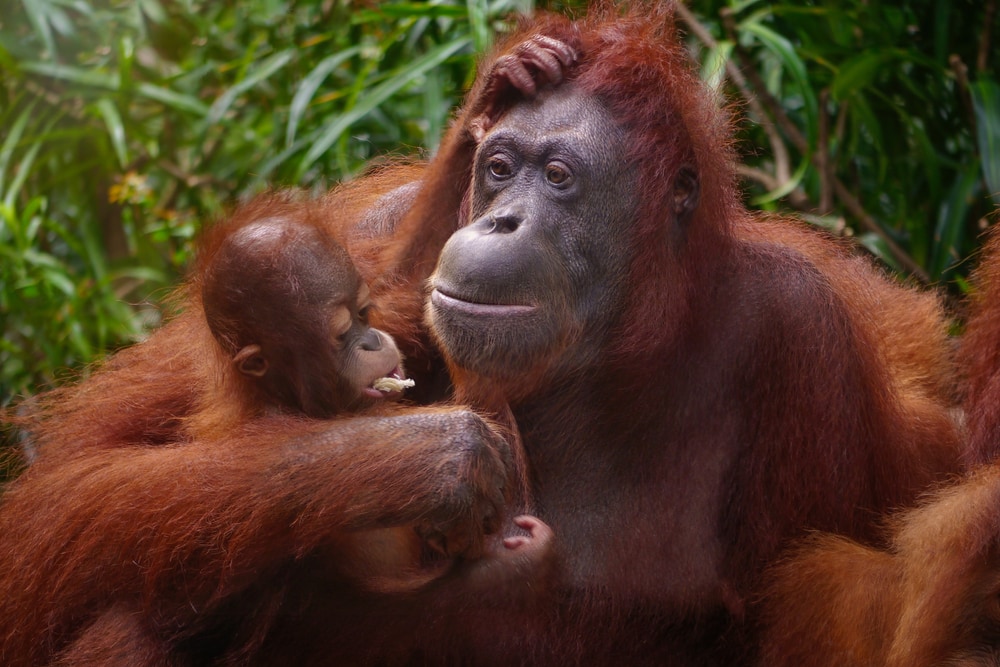
Scientists describe Sumatran orangutans as having five lifecycles. They change their appearance and behavior, much like humans.
Stage 1: Infancy
Newborn infants have pink faces with tufts of hair standing up and weights between 4.4 to 13 lb (2 to 6 kg). During infancy, the baby depends on his mother for feeding. It will hang tight to her belly when she swings in search of food. This stage ends when the infant reaches 2 years and a half.
Stage 2: Juvenile- Hood
During this stage, the juvenile gets heavier, weighing between 13 to 33 lb (6 to 15 kg). However, they don’t change much physically. Their mothers still carry them, but this time piggyback style.
They start playing with other juveniles and move around independently of their mothers. However, they remain in their vision. This stage ends at about 5 years old when the child stops sleeping in their mother’s nest and builds their own
Stage 3: Adolescent
An adolescent orangutan weighs around 33 to 60 lb (15 to 30 kg). Their faces start to darken up, losing their juvenile appearance. They stay in contact with their mothers and develop peer relationships. However, they are wary of male adults, so they act with caution.
From 8 years old, a female orangutan reaches adulthood and can have offerings. Males enter another stage, not yet ready for mating.
Stage 4 only for males: Sub-adulthood
This stage lasts from 8 years to 13 years. Males’ faces become entirely dark and develop their flanges or cheek pads.
They also get their beards, and the hair around their faces stops pointing outwards. They get a more serious look with their hair flattened against their face. They will still avoid contact with other adult males.
Stage 5: Adulthood
Sumatran male orangutans reach adulthood between 13 to 15 years old. From cute and fuzzy infants, they transform into these giant mammals. They have fully grown beards and prominent cheeks. In addition, they are sexually mature and will only travel alone.
A female orangutan lives up to 53 years in the wild, while males live longer, up to 57 years. Studies show that females can have babies until they are 53 years old.
It is because they do not experience menopause. Both genders are healthy until their life ends based on their fluffy hair and big cheeks.
The oldest orangutan in the world was Inji, a Sumatran female who died at 61 years old in her home at Oregan Zoo.
You may also like: The Siamang: All About The Loudest & Largest Gibbon
Population
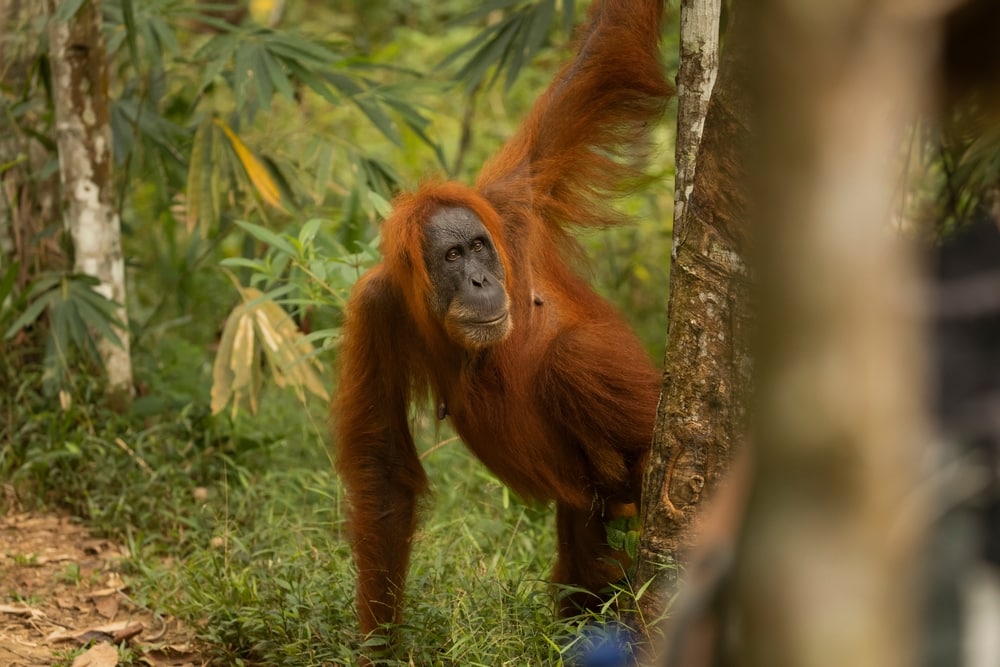
The most recent assessment of their numbers is roughly 13,800 individuals. These numbers are higher than their previous estimate of 6,000 individuals in 20008. There are several reasons for this.
They found orangutans living at higher altitudes than previously known. Sumatran orangutans were more widely distributed than initially assumed. Some populations got found in previously unsurveyed forests.
Engagement Status
According to IUCN’s Red List, the Sumatran orangutan has been considered critically endangered. Their numbers are decreasing.
You may also like: How Long Do Monkeys Live? From Old World To New World
Known Conservation Strategies

Two conservation methods are being deployed to save the Sumatran orangutans.
The first one is to rehabilitate and reintroduce captive or displaced individuals. This method means they can safely reproduce in captivity and then release back into the wild.
The issue with this method is that orangutans can suffer from the “Captivity Effect.” Animals in captivity are safe, don’t have natural predators, and don’t need to forage for food.
Animals that stay longer in captivity forget how to behave in their natural habitat. It is because, in captivity, they don’t have challenges.
The second method is to protect their forest habitat from deforestation. The first method is more cost-efficient, but it can take up to 20 years for rehabilitation. This second method offers long long-term stability for the species.
Also, 70 individuals have a new home in Bukit Tigapuluh National Park. This current population is thriving and reproducing. But, reintroducing confiscated orangutans to the wild is more expensive than forest conservation.
You may also like: 25 Remarkable Types Of Monkeys (Names, Photos And More)
Threats and Predators
Humans are their main threat. Sumatra has the highest deforestation rate in the world. These forests get destroyed to make palm oil plantations. Indonesia is one of the top wood suppliers, and 70% is from illegal logging, making orangutans highly vulnerable.
Poachers kill female orangutans and sell their babies as illegal pets. As pets, they live short and depressing lives. Sometimes they get rescued by an orangutan organization.
Their natural predators are clouded leopards, pythons, crocodiles, and tigers.
You may also like: What Is Poaching And Why Is It Practiced?
Ecological Role
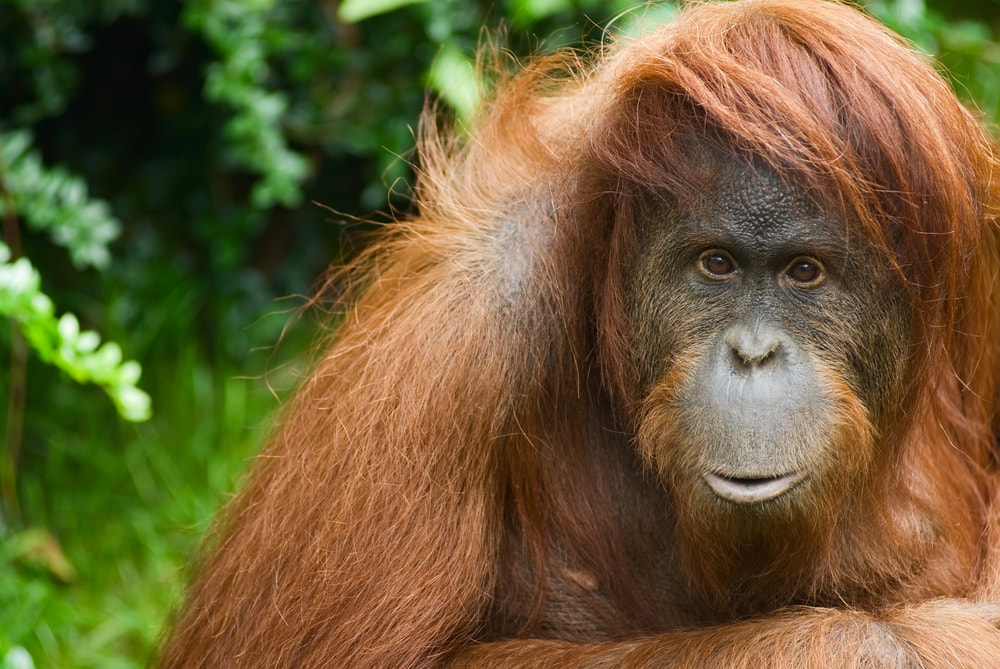
Sumatran orangutans are a keystone species for Sumatra. Since they eat plenty of fruits, they spread the seeds throughout the forest. It helps maintain the biodiversity of their ecosystem. They also help plants regenerate because they only eat green leaves.
You may also like: 10 Keystone Species Examples And The Important Role They Play In Every Ecosystem
Sumatran Orangutan Fun Facts
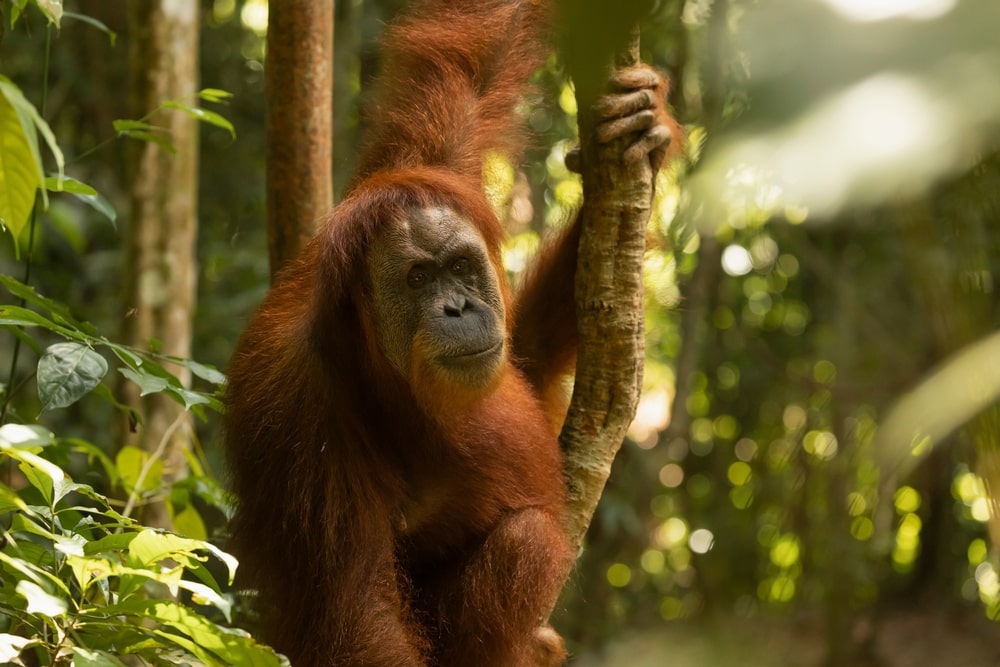
Orangutans are our closes relatives. Our DNAs are 97% match. In 2014, an orangutan was ruled a “non-human person” as it had the same fundamental rights of personhood.
Sandra, the orangutan, was illegally detained at a zoo in Argentina, and a judge ruled it has the right to live free. Sandra was moved to a great ape sanctuary in Florida.
They aren’t as social as other apes like bonobos or chimpanzees. They don’t like to live in groups, and the males are strictly solitary creatures.
Like humans, orangutans have 32 teeth. They also hate mosquitos as much as we do and use branches to make them disappear.
You may also like: Golden Snub-Nosed Monkey: All About The Monkey Who Loves Snow
Sumatran Orangutan FAQs
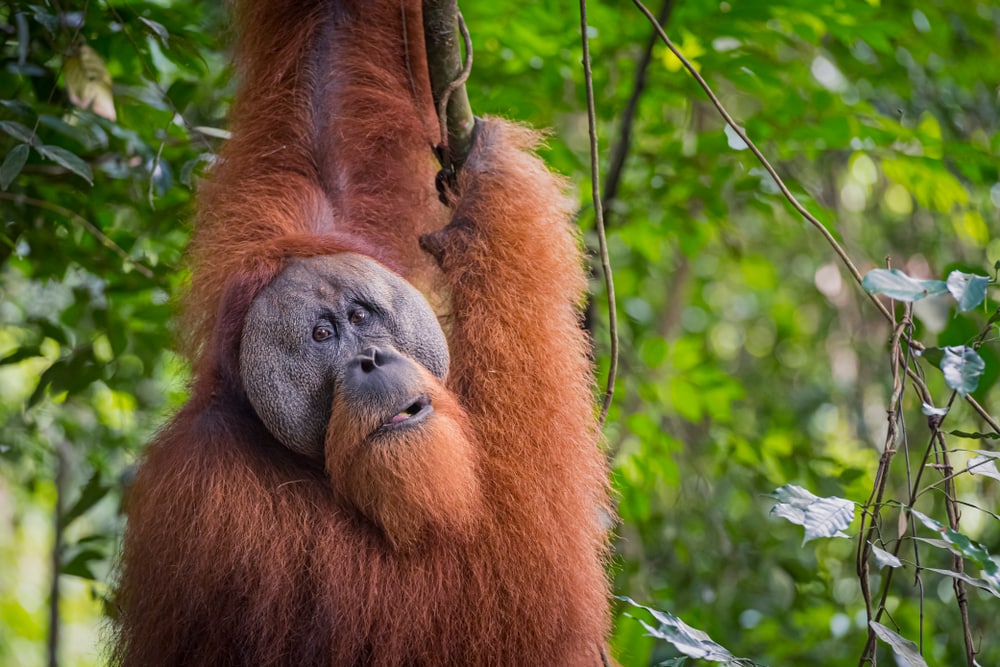
How many Sumatran orangutans are left in 2022?
The Sumatran orangutan population is declining, with only 13,846 individuals left.
Are Sumatran orangutans friendly?
Orangutans are generally friendly towards humans and other orangutans. However, orangutans kept in care and reintroduced to the wild are aggressive.
What happens when an animal goes extinct?
When an animal goest exists, an entire chain reaction occurs. The animals that used to eat that animal need to find another food source or starve. If a predator goes extinct, the prey multiplies, and their numbers go out of balance.
What are orangutans killed for?
Orangutans get hunted for their meat, illegal pet trades, and for fear of destroying crops.



